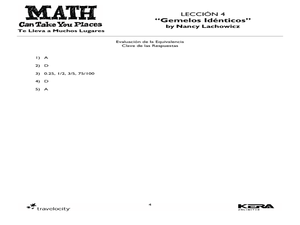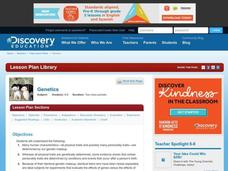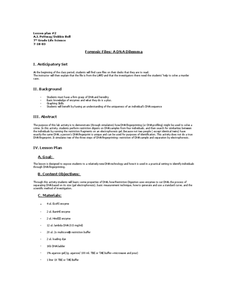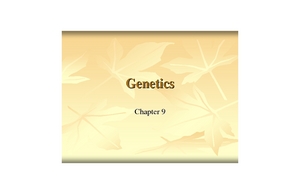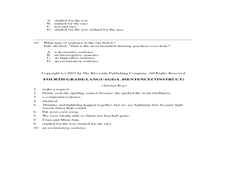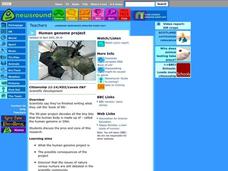National Center for Case Study Teaching in Science
Identical Twins, Identical Fates?
Can different personal experiences affect our genes? Find out in an intriguing case study about one twin who is diagnosed with mental illness and her identical twin who fears she may suffer the same fate. Designed for college-level...
Curated OER
Identical Twins
Sixth graders work with equivalent fractions, decimals, and percents. In this equivalency lesson, 6th graders participate in a number of activities aimed at increasing their understanding of equivalent expressions. They form a human...
Curated OER
Twins!
Students study genetics and how twins can be identical. In this genetics instructional activity students research twins and how heredity, environment and personality play a part.
Curated OER
Pregnancy, day 1
A health lesson presents all aspects of conception and pregnancy. Fourth through sixth-graders define terms associated with pregnancy, label a chart of a woman, and discuss how pregnancy occurs. Some excellent activities and a wonderful...
Curated OER
Genetics
Comprehend that many human characteristics-all physical traits and possibly many personality traits-are determined by our genetic makeup. These activities demonstate that all physical traits are genetically determined, some evidence...
Curated OER
The Human Mind
Pupils read and discuss twin studies to explore the debate of nature vs. nurture. They create a list of characteristics and then look for evidence of whether it is primarily a genetic or environmental characteristic. All of the...
Curated OER
Town Meeting - Direct Representation
Students answer the question, "Should the town of Twin Cheeks ban motorized rentals on Thome Lake?" They explore the political, personal, and economic issues involved in making this decision as they assume different roles in this...
Cornell University
Forensic Science: Case of the Missing Diamond Maker
Someone stole a diamond-making machine. Who done it? Scholars use forensic science at six different stations to determine the culprit. They analyze fingerprints, use their senses, and complete chemistry experiments to determine the...
Curated OER
Measurement and Variation
Examine the concept of variation through observation and measurement. Middle schoolers will study a peanut and record any distinguishing characteristics visible as well as sketch their peanuts and describe them in writing. Their peanut...
Curated OER
Forensic Files: A DNA Dilemma
Seventh-graders come in to science class to find a file on their desks detailing a crime to be solved! As a demonstration, you simulate the restriction of DNA samples and separate them by electrophoresis. From the gel, learners can...
Curated OER
Genetics
Students create a checklist of traits common in all of their families. Uisng a table, they compare and contrast their family members to non-family members. They also review dominant and recessive traits and discuss how knowing about...
Curated OER
The Living Corn Necklace
Fifth graders generate two types of corn seeds, Dent corn and Indian corn to compare the similarities and differences of each of the seedlings. The preferred seedlings are determined through observations made by Students.
Curated OER
Mendelian and Non-Mendelian Heredity
Tenth graders discuss their physical features, and why they look the way they do. They listen as the teacher discusses DNA, alleles, and dominant or recessive genes. Students perform an experiment with different colored markers...
Curated OER
Our Healthy Bodies
Students complete a variety of activities designed to enhance their awareness of their bodies. They examine pictures of themselves, taken at various points in the year and examine and compare their bodies. They enjoy a healthy snack...
Curated OER
What Is Cloning?
Students differentiate between reproductive and therapeutic cloning and then use research, discussion, and writing in journals to examine their own personal opinions on these subjects.
Curated OER
Investigating Fingerprints
Young scholars study the individuality of fingerprints. In this fingerprint lesson, students determine that each person has a unique set of fingerprints. They rub their fingertips with soft pencil lead and rub the print off on a piece of...
Curated OER
Genes and Heredity
Students identify different traits and whether the traits are inherited or acquired.
Curated OER
Genetics: You Are Unique
Students investigate genetics as the study of inherited traits. They complete a worksheet.
Curated OER
Whodunit?
Students observe the geometric patterns on fingerprints. They classify fingerprints into groups and obtain prints from surfaces.
Curated OER
Skin: Skin Prints
Learners explore human anatomy by participating in a print experiment. In this human skin instructional activity, students define the term "epidermis" and utilize computer paper, pencils, tape and baby wipes to create a print of their...
Curated OER
Transformations and Exponential Functions
Tenth graders study graphing exponential functions. In this transformations lesson, 10th graders apply inquiry to determine how changes to a parent function affect its graph. Students analyze transformed graphs and generate the function...
Curated OER
Sentence Stucture
For this analyzing sentences worksheet, 4th graders identify purpose, combining, types, and grammar. Students answer 10 questions.
Curated OER
Human genome project
High schoolers research writings on "the book of life." Students research the human genome project. High schoolers discover the issues of nature versus nurture are still hashed over in the scientific community.
Curated OER
Living Corn Necklace
Fifth graders explore heredity and observable traits through experimentation. They view several different types of corn and record their observation of physical traits on a class chart. They create a corn necklace by sprouting dried...

